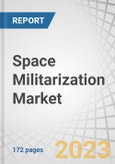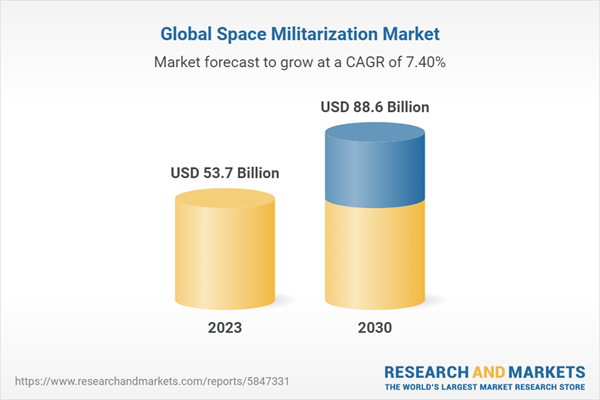Governments and private entities may invest in space militarization to protect their economic interests, such as securing satellite communication networks or defending critical space-based assets is expected to drive the market.
The Space Militarization market is projected to grow from USD 53.7 Billion in 2023 to USD 88.6 Billion by 2030, at a CAGR of 7.4% during the forecast period. Deployment of satellite ground stations for military purposes to drive the market.
The Defense segment is projected to witness the highest CAGR during the forecast period
Based on Capability, the Defense segment of the Space Militarization market is projected to hold the highest growth rate during the forecast period. The competition to become the space power national drives the development of new ISR, EW, and space-based weapons. Countries are developing these weapons to protect their space assets and deter attacks from other countries. For example, China and the United States are both developing new space-based weapons, such as ASAT weapons and directed energy weapons.
The Navigation segment is projected to dominate the Space Militarization market
Based on sub-capability, the navigation segment dominates the space militarization market. The increasing need for precise and dependable navigation systems is a prominent catalyst driving the navigation segment within the space militarization market. As military operations continue to evolve in complexity, there is a rising demand for enhanced precision and reliability in navigation systems.
The United States is expected to account for the largest market share of the Market
The Space Militarization market industry has been studied in the US, UK, New Zealand, India, Russia, China, Australia, Canada, Rest of the World. The US accounted for the largest market share in 2023. The US military has expressed escalating concerns regarding the rising menace posed by China and Russia within the realm of space. These nations are actively cultivating their own space-centric resources for military purposes while concurrently exploring novel technologies that could potentially target US space assets. Furthermore, the US military is making substantial investments in space militarization to uphold its military superiority and dissuade prospective adversaries.
The break-up of the profile of primary participants in the SPACE MILITARIZATIION market:
- By Company Type: Tier 1 - 40%, Tier 2 - 30%, and Tier 3 - 30%
- By Designation: C Level - 30%, Director Level - 20%, Others-50%
- By Region: North America -35%, Asia Pacific - 30%, Europe - 20%, Middle East & Africa - 10%, and Latin America - 5%
Prominent companies include General Dynamics Corporation (US), Raytheon Technologies Corporation (US), Airbus SE (Netherlands), Lockheed Martin Corporation (US), and Northrop Grumman Corporation (US), among others.
Research Coverage:
This research report categorizes the Space Militarization market by capability (Defense, Support), by solution (Spaced-Based equipment, Ground-Based Equipment, Logistics, and services), and by Country (US, UK, New Zealand, India, Russia, China, Australia, Canada, Rest of the World). The scope of the report covers detailed information regarding the major factors, such as drivers, restraints, challenges, and opportunities, influencing the growth of the Space militarization market. A detailed analysis of the key industry players has been done to provide insights into their business overview, solutions, services; key strategies; Contracts, partnerships, and agreements. New product & service launches, mergers and acquisitions, and recent developments associated with the Space Militarization market. Competitive analysis of upcoming startups in the Space Militarization market ecosystem is covered in this report.
Reasons to buy this report:
The report will help the market leaders/new entrants in this market with information on the closest approximations of the revenue numbers for the overall Space Militarization market and the subsegments. This report will help stakeholders understand the competitive landscape and gain more insights to position their businesses better and plan suitable go-to-market strategies. The report also helps stakeholders understand the pulse of the market and provides them with information on key market drivers, restraints, challenges, and opportunities.
The report provides insights on the following pointers:
- Market Driver: Analysis of key drivers and there are several factors that could contribute to an increase in the space militarization market.
- Market Penetration: Comprehensive information on Space Militarization offered by the top players in the market
- Product Development/Innovation: Detailed insights on upcoming technologies, research & development activities, and new product & service launches in the Space Militarization market
- Market Development: Comprehensive information about lucrative markets - the report analyses the Space Militarization market across varied regions
- Market Diversification: Exhaustive information about new products & services, untapped geographies, recent developments, and investments in the Space Militarization market
- Competitive Assessment: In-depth assessment of market shares, growth strategies, and service offerings of leading players in the Space Militarization market
Table of Contents
Companies Mentioned
- Airbus
- Aselsan A.S.
- Bae Systems plc
- China Aerospace Science and Technology Corporation
- General Dynamics Corporation
- Israel Aerospace Industries Ltd.
- L3Harris Technologies, Inc.
- Leonardo S.P.A.
- Lockheed Martin Corporation
- Northrop Grumman Corporation
- Raytheon Technologies Corporation
- Saab Ab
- Space Exploration Technologies Corporation (Spacex)
- Teledyne Technologies Inc.
- Thales Group
- The Boeing Company
Methodology

LOADING...
Table Information
| Report Attribute | Details |
|---|---|
| No. of Pages | 172 |
| Published | June 2023 |
| Forecast Period | 2023 - 2030 |
| Estimated Market Value ( USD | $ 53.7 Billion |
| Forecasted Market Value ( USD | $ 88.6 Billion |
| Compound Annual Growth Rate | 7.4% |
| Regions Covered | Global |
| No. of Companies Mentioned | 16 |









